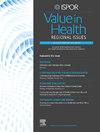Valuing an Index of Sanitation-Related Quality of Life in Urban Mozambique: A Discrete Choice Experiment
IF 1.4
Q3 HEALTH CARE SCIENCES & SERVICES
引用次数: 0
Abstract
Objectives
A total of 1.5 billion people live without basic sanitation. A 5-attribute index of sanitation-related quality of life (SanQoL-5) has been applied in 9 countries. SanQoL-5 attributes and their levels require weighting (valuation), with the resulting index ranging from 0 to 1. To date, SanQoL-5 valuation applied simple methods such as rank sum, not robust methods such as discrete choice experiment (DCE). We aimed to value SanQoL-5 using a DCE in urban Mozambique.
Methods
We enrolled 601 adults in the cities of Maputo and Dondo, sampling women and men equally. The DCE task was a choice of which was “better” among 2 combinations of SanQoL-5 attribute levels (always, sometimes, never). Each respondent completed 10 tasks and a dominance test. After fitting a mixed logit model, we rescaled coefficients to derive the index.
Results
The highest-valued attribute was disgust (“never feel disgusted while using the toilet”) at 0.25. The other attributes had similar values (ranging 0.18-0.19). People valued “sometimes” levels at approximately 60% of “never” levels. Therefore, moving from the middle level to the worst involves a larger decrement than moving from the best to the middle. Mean SanQoL-5 by toilet type followed a gradient with Sustainable Development Goal 6 categories: “open defecation” 0.30, “unimproved” 0.45, “limited” 0.60, and “at least basic” 0.70.
Conclusions
To our knowledge, this is the first DCE-based valuation of any index of sanitation-related quality of life, enabling SanQoL-5 to be used in economic evaluation. Identifying sanitation service transitions associated with the greatest quality of life gains could inform more efficient resource allocation.
评价莫桑比克城市卫生相关生活质量指数:离散选择实验
目的全球共有15亿人缺乏基本卫生设施。卫生相关生活质量的五属性指数(SanQoL-5)已在9个国家应用。SanQoL-5属性及其级别需要加权(估值),得到的指数范围从0到1。迄今为止,SanQoL-5估值应用了简单的方法,如秩和,而不是稳健的方法,如离散选择实验(DCE)。我们的目标是在莫桑比克城市使用DCE评估SanQoL-5。方法我们在马普托和东多市招募了601名成年人,男女抽样相同。DCE任务是在SanQoL-5属性级别的2种组合中选择哪一种“更好”(总是,有时,从不)。每个被调查者完成了10个任务和一个支配性测试。在拟合混合logit模型后,我们重新缩放系数来推导指数。结果厌恶(“上厕所时从不感到恶心”)属性值最高,为0.25。其他属性具有相似的值(范围为0.18-0.19)。人们对“有时”级别的重视程度大约是“从不”级别的60%。因此,从中间水平到最差水平的减量要比从最好水平到中间水平的减量大。厕所类型的平均SanQoL-5遵循可持续发展目标6类别的梯度:“露天排便”0.30,“未改善”0.45,“有限”0.60和“至少基本”0.70。据我们所知,这是第一次基于dce对卫生相关生活质量指标进行评估,使SanQoL-5能够用于经济评估。确定与最大程度提高生活质量相关的卫生服务转型,可为更有效地分配资源提供信息。
本文章由计算机程序翻译,如有差异,请以英文原文为准。
求助全文
约1分钟内获得全文
求助全文
来源期刊

Value in health regional issues
Pharmacology, Toxicology and Pharmaceutics-Pharmacology, Toxicology and Pharmaceutics (miscellaneous)
CiteScore
2.60
自引率
5.00%
发文量
127
 求助内容:
求助内容: 应助结果提醒方式:
应助结果提醒方式:


